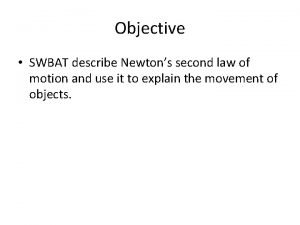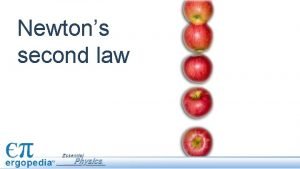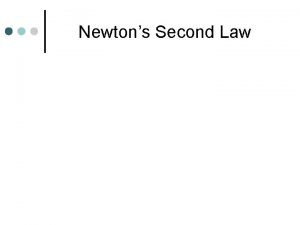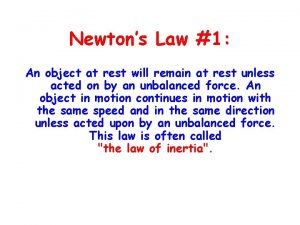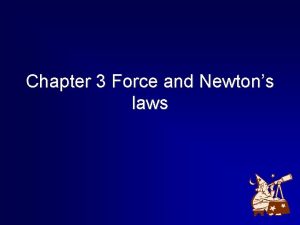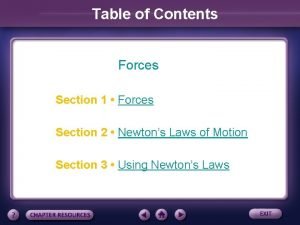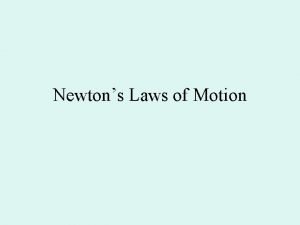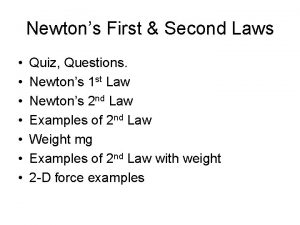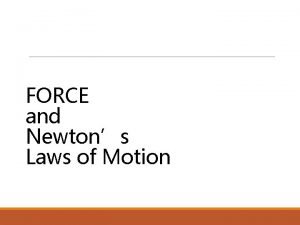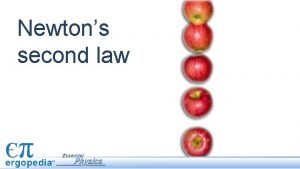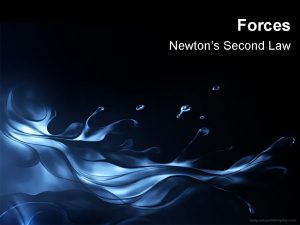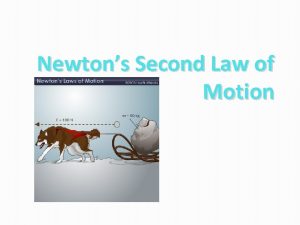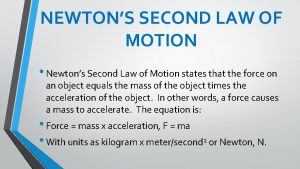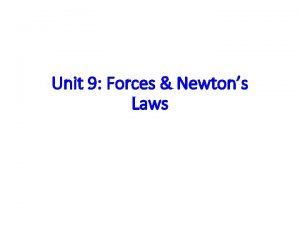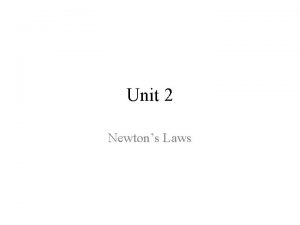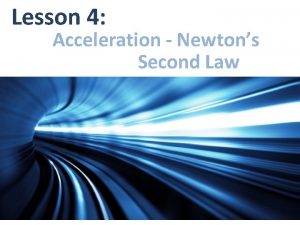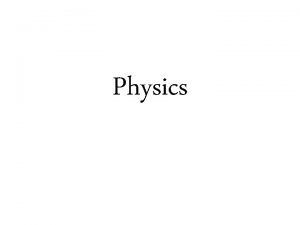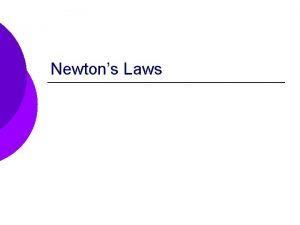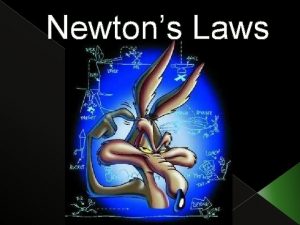Newtons Second Law Unit V Newtons Laws of



















- Slides: 19

+ Newton’s Second Law Unit V – Newton’s Laws of motion

+ Newton’s Laws of motion review n An object will only accelerate if there is a net force (unbalanced force) acting upon it. n The presence of an unbalanced force will accelerate an object n Changing its speed, its direction, or both its speed and direction. n Newton’s second law pertains to the behavior of objects for which all existing forces are NOT balanced.

+ Newton’s second law n The second law states that the acceleration of an object is dependent upon two variables: n The net force acting upon the object n The mass of the object. n The acceleration of an object depends directly upon the net force acting upon the object and inversely upon the mass of the object. n As force is increased, the acceleration is increased. As the mass increases, the acceleration decreases.

+ Newton’s second law of motion n The acceleration of an object as produced by a net force is directly proportional to the magnitude of the net force, in the same direction as the net force, and inversely proportional to the mass of the object. n The equation is a = Fnet / m or F net = m x a n where a is acceleration, F is net force and m is mass of object n The NET FORCE must be used in this equation (you cannot just use any force that is given in the problem, it must be NET force). n 1 Newton = 1 kg x m/s 2

+ Newton’s Second Law problems n Determine the acceleration that results when a 12 N net force is applied to a 3 kg object and then to a 6 kg object. n Suppose that a sled is accelerating at a rate of 2 m/s 2. If the net force is tripled and the mass is doubled, then what is the new acceleration of the sled?

+ Misconceptions n The misconception that to sustain motion requires a continued force. n Two students are discussing their physics homework prior to class. They are discussing an object that is being acted upon by two individual forces (both in a vertical direction); the freebody diagram for the particular object is shown at the right. During the discussion, Anna Litical suggests to Noah Formula that the object under discussion could be moving. In fact, Anna suggests that if friction and air resistance could be ignored (because of their negligible size), the object could be moving in a horizontal direction. According to Anna, an object experiencing forces as described at the right could be experiencing a horizontal motion as described below. Noah Formula objects, arguing that the object could not have any horizontal motion if there are only vertical forces acting upon it. Noah claims that the object must be at rest, perhaps on a table or floor. After all, says Noah, an object experiencing a balance of forces will be at rest. Who do you agree with?

+ Finding Acceleration n Equations n Net useful for solving problems: Force n Gravitational n Frictional F net = m x a Force Fgrav = m x g F frict = μ x F norm

+ Acceleration Example problems: n An applied force of 50 N is used to accelerate an object to the right across a frictional surface. The object encounters 10 N of friction. Use the diagram to determine the normal force, the net force, the mass, and the acceleration of the object. (Neglect air resistance. ) Image from The Physics Classroom

+ Acceleration Practice problem n A 5 -kg object is sliding to the right and encountering a friction force that slows it down. The coefficient of friction (μ) between the object and the surface is 0. 1. Determine the force of gravity, the normal force, the force of friction, the net force, and the acceleration. (Neglect air resistance. )

+ Finding Individual Forces problems n. A rightward force is applied to a 6 kg object to move it across a rough surface at constant velocity. The object encounters 15 N of frictional force. Use the diagram to determine the gravitational force, normal force, net force, and applied force (neglect air resistance). Image from the Physics Classroom

+ Free fall and air resistance problems n Acceleration due to gravity is 9. 8 m/s 2 n It is called acceleration of gravity and uses the symbol “g” n Why do objects that encounter air resistance ultimately reach terminal velocity and why do more massive objects fall faster than less mass objects in the presence of air resistance? n Must use Newton’s second law of motion to answer the questions.

+ Free fall and air resistance problems n Free fall is a special type of motion where the only force acting on the object is gravity. n In free fall, all objects will fall with the same rate of acceleration regardless of their mass. n Acceleration Force n Mass n depends upon two things:

+ Free Fall and air resistance problems n Compare a 1000 kg cow to a 1 kg kitten. The cow has more mass thus more inertia. n Cow’s acceleration = 10, 000 N / 1000 kg n Acceleration n Kitten’s acceleration = 10 N / 1 kg n Acceleration n The = 10 m/s/s ratio of Force to mass is the same for either animal.

+ Free fall and air resistance problems n The ratio is sometimes called the gravitational field strength and is expressed as 9. 8 N/kg. n All objects on earth’s surface will experience this amount of force (9. 8 N) upon every 1 kg of mass of the object. n The gravitational field strength differs based upon other planets. It varies also on the surface of the earth based upon how close or far away from the equator a person is or how high the altitude is.

+ Falling with Air Resistance n Air resistance is the result of collisions of the object’s leading surface with air molecules. n Air resistance depends upon several factors: Speed of the object n Cross-sectional area of the object n n Increased speeds result in an increased amount of air resistance. Increased cross-sectional areas result in an increased amount of air resistance.

+ Falling with Air resistance n As an object falls, it picks up speed. The increase speed then increases air resistance. The force of air resistance then balances the force of gravity. At this point the object has reached it’s terminal velocity. The force of air resistance equals the force of gravity on the object thus the object’s velocity is at it’s terminal velocity.

+ Two body Problems n. A 5. 0 -kg and a 10. 0 -kg box are touching each other. A 45. 0 -N horizontal force is applied to the 5. 0 -kg box in order to accelerate both boxes across the floor. Ignore friction forces and determine the acceleration of the boxes and the force acting between the boxes.

+ Two body problems n. A man enters an elevator holding two boxes - one on top of the other. The top box has a mass of 6. 0 kg and the bottom box has a mass of 8. 0 kg. The man sets the two boxes on a metric scale sitting on the floor. When accelerating upward from rest, the man observes that the scale reads a value of 166 N; this is the upward force upon the bottom box. Determine the acceleration of the elevator (and boxes) and determine the forces acting between the boxes.

+ Works Cited n The Physics Classroom. (2013). Newton’s Laws Lesson 3. Retreived from http: //www. physicsclassroom. com/Class/newtlaws/U 2 l 3 c. cfm
 Newton's first law and second law and third law
Newton's first law and second law and third law Newton's first law and second law and third law
Newton's first law and second law and third law Newtons second law in soccer
Newtons second law in soccer Describe newtons second law
Describe newtons second law Newton's second law
Newton's second law Examples of newton's second law
Examples of newton's second law Newtons second law
Newtons second law Newtons second law example
Newtons second law example Facts about newtons laws
Facts about newtons laws 6 67 x 10^-11
6 67 x 10^-11 Newtons 3 laws
Newtons 3 laws Newtons laws of gravity
Newtons laws of gravity Section 3 using newton's laws
Section 3 using newton's laws Section 3 using newtons laws
Section 3 using newtons laws Section 3 using newtons laws
Section 3 using newtons laws Newtons laws od motion
Newtons laws od motion What are newtons 3 laws
What are newtons 3 laws Section 2 newtons laws of motion
Section 2 newtons laws of motion Newtons 3 laws quiz
Newtons 3 laws quiz Newton's 3rd law example
Newton's 3rd law example



